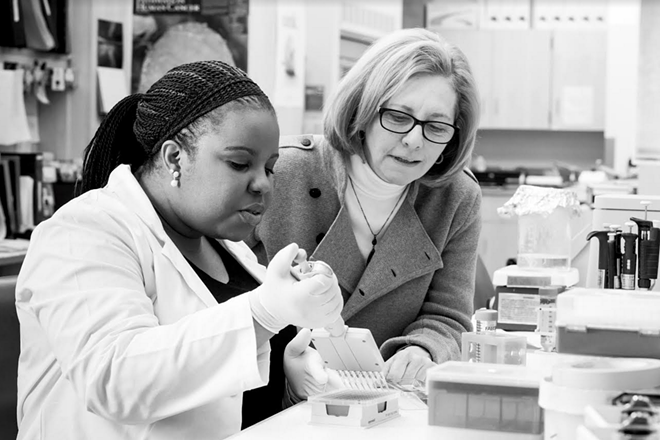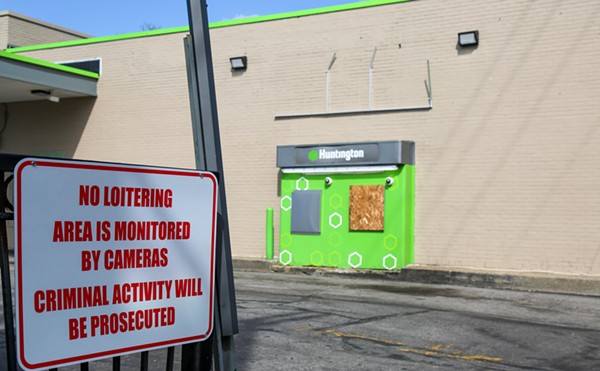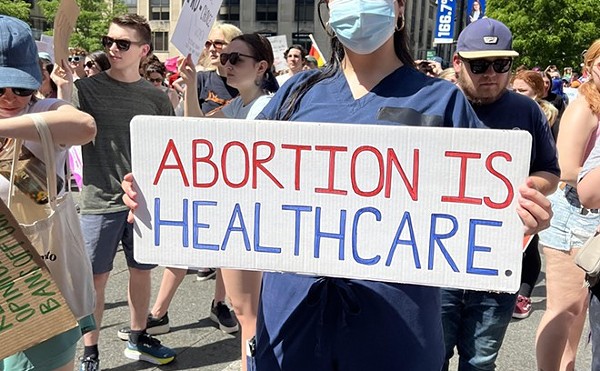CWRU's Dr. Ruth Keri on Misunderstandings in Cancer Research, Underrepresentation of Women in Science, and NIH Funding
By Amar Desai on Wed, Jan 4, 2017 at 12:45 pm
[
{
"name": "Ad - NativeInline - Injected",
"component": "38482495",
"insertPoint": "3",
"requiredCountToDisplay": "5"
},{
"name": "Real 1 Player (r2) - Inline",
"component": "38482494",
"insertPoint": "2/3",
"requiredCountToDisplay": "9"
}
]
While the numbers for the biomedical research community in Cleveland themselves are absolutely astounding (I would reference the BioOhio Bioscience Growth Report for specifics on the ~$5 billion industry here in Ohio), what I find more impressive is the groundbreaking research that pushes boundaries daily on how we understand and treat disease. Every week it seems like scientists at one of Cleveland’s major research institutions publish an important study that pushes their respective fields forward; whether it’s a novel therapy to treat colon cancer, a computer model to predict cancer cell network activity, or identifying a potential marker to preserve cognitive function in the elderly, the scientists and staff at Case Western Reserve, the Cleveland Clinic, and University Hospitals work tirelessly to make sure Cleveland remains at the forefront of biomedical research.
In an effort to put faces to that work and present a non-clinical portrait of what it means, we occasionally chat with one of the local leaders in their field. Today, that's a conversation with Dr. Ruth Keri, Associate Director for Basic Research at Case Comprehensive Cancer, to talk about her career in science, the current state of research in Cleveland, the underrepresentation of women in science, and common misunderstandings about cancer research.
What type of research does your lab focus on, and what are the challenges and goals that lie ahead for your work?
My laboratory focuses on breast cancer. There are several subtypes of breast cancer, each with its own nuances, but I like to say that we’re agnostic. If it is an interesting problem and we have the tools to study it, we will. Breast cancer, like most other cancers, is a disease of inappropriate development. This can either be during the typical development that occurs during puberty, or other stages of breast development that are re-awakened during the cancer-forming process. Thus, my group also works on the developmental biology of the breast. We want to know what makes cancers tick and how can we stop the clock. We focus on inappropriate activation or suppression of genes and proteins that contribute to the ability of cancer cells to grow, move, or live in other environments as occurs when a breast cancer metastasizes to other tissues. Our ultimate goal is to find new therapies, thus whenever we find a new path that cancer cells take, we look in our tool box of drugs to identify road blocks for that path. We then use mouse models of breast cancer to test these therapies.
One of the most exciting parts of my lab is the identification of new combinations of drugs that are more effective than either drug alone. We expect that treating patients with such combinations will have a greater ability to produce sustained cures of this disease. We would like to use these approaches in clinical trials, but this is a major hurdle for a basic scientist (PhD) such as myself. It requires collaborations with medical oncologists that can design and implement clinical trials. It also requires funding from major drug companies to support such a trial. While I have met many physicians interested in our findings, the current state of the health care system makes high demands on their time, leaving little remaining for conducting new therapeutic trials. In addition, if two drugs being investigated are generated by different companies, it is very difficult to get those companies interested in collaborating due to issues of patents, profits, and liability. As a result, many new findings, not just from my lab, have not been able to traverse the divide between bench and bedside. Such activities need to be encouraged and this can only happen by supporting the research of our physicians and scientists and their collaborative development of trials.
In addition to this hurdle, I would say that another major challenge is the state of funding for all of biomedical research in the USA. It is notable that from 2012 to 2013, China increased their scientific R&D spending by 15% whereas the United States decreased its support by 5% and this trend is continuing. In fact, the success rate for grant applications to the National Institutes of Health has gone down from ~30% when I started my laboratory to about 18% now. This is unsustainable and is resulting in the shuttering of many labs and an inability of others to get off the ground. As a result, many great ideas are landing on the cutting room floor. This will undoubtedly impact our country’s status as leaders of innovation worldwide.
What do you think is the number one misconception the general public has about cancer and cancer research?
I have heard many times that we have “lost the war on cancer” or that we have failed the public by not yet finding cures for this disease. If we can place a man on the moon, why can’t we cure cancer? These statements reflect a basic misconception that cancer is a unitary problem. In fact, each cancer type is its own disease, and further adding complexity, each person’s cancer is as unique as they are. This is due to extreme genetic heterogeneity in cancer that we have not really mastered. Considering that there are ~20,000 genes in the human genome and that many of these can contribute to the nature of a person’s cancer, it is not surprising that complexity is the norm and not the exception. We simply haven’t learned enough about that complexity. Thus, I would say that putting a man on the moon was an infinitely easier prospect that curing cancer in every patient.
We are, however, making great strides. Certain childhood cancers were once death sentences and now most children affected with specific leukemias survive. Likewise, we had no treatments for melanoma just 6 years ago, but now have therapies that extend the lives of such patients. Many might say that we know enough about cancer biology to now move our findings into the clinical realm. Even the Cancer Moonshot focuses on using the information we currently have versus making additional discoveries. However, I would say that while we now have many successes, we have many more challenges. Basic understanding of cancer mechanisms is still in its infancy and this must be remedied to make substantial progress and discover new targetable alterations that drive cancer aggressiveness. Indeed, some of the key cancer targets have only recently been discovered in the past decade and I expect there are many more to be found. In addition, while we have many new drugs, discerning why these drugs fail is the essential work of the lab-based scientist. Focusing on both will be necessary before we can really generate sustained cures in the majority of patients.
What are your thoughts on the state of women in science and academia as a whole? Do you believe efforts are being made in Cleveland to promote women to pursue STEM careers?
The number of women in science continues to be less than that of the population, with only 30% of all faculty at the CWRU School of Medicine being female. In the words of Bill Nye the Science Guy, “Half the humans are girls and women, so we want half the engineers and scientists to be girls and women.” The number of women beginning in science careers appears to be roughly equal to men, although the distribution across disciplines is highly varied. When I was a graduate student some 30 years ago, roughly half of the graduate students in biomedical sciences were women. So, why are we only at 30% of faculty being women? We clearly have a problem with attrition in STEM fields. I think that this is a societal issue. Being a scientist is demanding! I would say that I work at least 60 hours per week. This is not easy to do with a family. Luckily, I had a support structure that encouraged my career growth, but many others do not have this advantage. We need to provide ways for women and men in science with children to have the confidence that their kids are being nurtured to grow into independent adults. One way to help is to have day care services available at places where they work. Our society also expects that parents are available during working hours. For example, the PTA at my kids’ school met at 3:00 in the afternoon on a weekday and soccer practices were at 5:00 pm. This cannot be accomplished while trying to get that next NIH grant. Thus, we as a society need to rework our structure of how we support and nurture our children that considers the realities of two working professional parents.
Another essential piece is to have appropriate mentoring for women faculty who have some unique needs from their male counterparts. Women need role models who are other women. I think we are getting there, but there is a lot more to do. Women who are established in their careers need to volunteer to advise other women. One of the pitfalls of being a woman faculty member is that you are asked to be on every committee because you are a woman. This is not only offensive, but divisive to success. Women should be empowered to serve when they can, but also to protect their own career development.
At the CWRU School of Medicine, we have made significant strides in achieving gender balance. Our Dean is a women and we now have parity in salaries for our new assistant professors. In addition, the number of women who hold endowed chairs, an honor indicating intrinsic value to the University, has been increasing. Most importantly, the school initiated formal mentoring activities a few years ago and I think this has, and will continue to improve the career trajectory of both our male and female faculty. The key here is understanding the unique needs of each faculty member and working with them to build on their strengths, recognize their weaknesses, and give them opportunities to grow. This takes a conscientious effort on the part of every mentor and I think we, as a School, are accomplishing these goals. It is important to note that the need for mentoring never ceases. I have outstanding mentors and I discuss various challenges with them quite often. My primary mentors are my doctoral advisor, my chair, and the Cancer Center director. That said, peer mentoring is also key. Good advice isn’t mandated by a rank or a direction. What I have learned is that everyone is wise in their own way and we can always learn from the people around us if we’re just willing to listen.
Overall, the need for gender balance is just a piece of a larger deficit of diversity in science. Great ideas are not limited by economic, social, ethnic, or gender background. Indeed, building upon these different perspectives should accelerate our rate of discovery and improvement of the human condition. While gender balance is on a good trajectory, I would say that diversity in other areas is lagging. This is largely due to a limited pipeline. There are numerous programs that the CWRU SOM has initiated to feed that pipeline and I have witnessed remarkable successes as a result. We have programs targeted to local high schools, exposing students to our mysterious world. I find this to be remarkable, particularly because I really didn’t know how research was done until I came to CWRU as a research assistant after graduating from college. These kids are learning that lesson in high school as well as seeing the potential for themselves in this realm. We also have programs that bring college students in for the summer to participate in research and others that prepare them for medical school. Lastly, we have a post-baccalaureate program for students from underrepresented backgrounds to facilitate their transition to graduate school. I have found this program to be particularly rewarding and it has led to significant diversity within my own laboratory. While the members of my team come from very different backgrounds, they are ardently supportive of one another and I believe this has provided a place for intellectual and emotional growth that will serve them well as they become independent scientists and shift the field to being more representative of our population.
Outside of the lab what are your interests and hobbies? Where are some of your favorite Cleveland hangouts?
Given my background, I am very industrious. I make things. This could be a great dessert, a nice piece of photography, some curtains, or redesigning a kitchen. I also really like to travel with my family—traveling to new countries gives me a great canvas for photography and new ideas for the next project I am going to complete. I also love learning about the history of the area and would consider myself an excellent travel agent. I identify “off the beaten path” activities for my trips. For example, I have climbed the ruins of the Great Wall of China, after climbing up a mountain pass to get there. I have been in Stonehenge at sunrise, swam in an underground river in Mexico, rode horses in Costa Rica, and toured the archeological dig underneath Saint Peter’s Basilica, among others.
Favorite Cleveland hangouts: I used to love going to the Barking Spider to hear American Folk and Bluegrass music. Unfortunately, it has recently shut down and I beg the owners to re-open it or to sell it to someone who has a similar vision! I also enjoy going to Playhouse Square for musicals and other shows. Within the past few weeks I went to see Rick Steves, a travel guidebook writer, give a talk on “Travel as a Political Act” and heard Straight No Chaser-an acapella group. I also really enjoy Little Italy. I like it so much that I recently bought a condo in the old schoolhouse. We are in the midst of renovating it and then I hope to spend about half of my time there.
Last question, what piece of advice would you give young people to help discover their passion? On top of that, what’s the best piece of advice anyone has given you?
First, I would say that passion isn’t something that hits you like a lightning bolt from the sky—that’s infatuation. Passion builds as you become ever more engaged in an activity and realize that you don’t want to live your life without it. Discovering your passion requires being exposed to diverse fields that might foster it. This means continuously and conscientiously trying new things and always being open to learning something new. You never know when you might find “the next big thing”. Thus, I would say that you need to foster an attitude of fearlessness within yourself. Then, when you realize you enjoy something, don’t hold yourself back. Dive in, commit, and see where it takes you. Don’t be afraid of the long hours and what you might be missing while working. It will be hard work, but if you still like what you are doing even after some long days and sleepless nights, and lots of thinking in the shower, you are on the right road. However, if you are working just to work or to satisfy some commitment to yourself or to someone else, then this is probably not the right path for you. Then you need to be fearless again to walk away and find something new. This is not to say every day will be a delight. There will be challenges and times that you think you should give up. But, if you love what you do, you will always come back the next day.
Best piece of advice: You will probably spend about 45 years working in your career. You need to find something that you like to do and that you ultimately don’t want to be without it. If you don’t have that, then you need to look for another career path. You also need to find a way to be invaluable. If you are invaluable to your colleagues/institution, they will help you accomplish any goal that you have.
Tags:
SCENE Supporters make it possible to tell the Cleveland stories you won’t find elsewhere.
Become a supporter today.
Scroll to read more Cleveland News articles
Newsletters
Join Cleveland Scene Newsletters
Subscribe now to get the latest news delivered right to your inbox.














